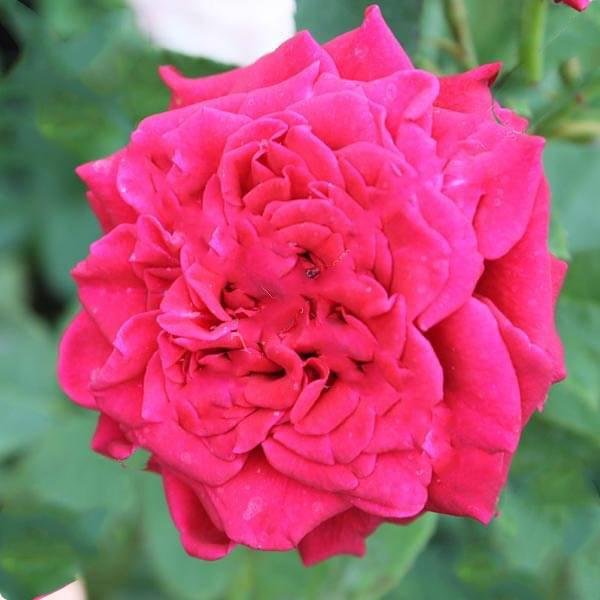Description
Roses are a group of herbaceous shrubs found in temperate regions throughout both hemispheres. Rose is considered by many as the most beautiful of all flowers.
Note: The fragrance of Rose flowers depends on its variety and climatic conditions, hence this plant may or may not produce fragrant flowers.The flowers are densely filled with petals. English roses are a good choice for cutting gardens. Some varieties climb if left unpruned and can be trained along a fence or arbour.The symbolism of rose colours is steeped in tradition. Roses inspired people over thousands of years to develop a language of colour.Plant Specifications
Plant Height
12 inch (30 cm)
Plant Spread
6 inch (15 cm)
*above specification are indicative only. actual dimensions may vary by +-10%
Common Name
English rose, Gulab
Maximum Reachable Height
3 to 8 feet
Flower Colour
Red
Bloom Time
Spring bloom, Summer bloom
Difficulty Level
Easy
Planting and careRoses, especially the repeat flowering varieties, need a generous supply of nutrients regularly through the growing season.Slow release or organic fertilizers applied to the ground are the most effective; however foliar feeds are also valuable for a quick effect and to help keep the leaves healthy. Mulching with organic matter (a very wide range is available) is a very important part of rose growing, helping to conserve water, keeping the ground cool and feeding the micro organisms and worms in the soil.It should preferably be well rotted and, if it starts to disappear during the season, be reapplied. The best way to keep your plants free from pests and diseases is to choose disease resistant varieties and to grow them as well as possible. Regular watering is essential, the rose will be stronger, healthier and, most importantly, produce more flowers.Early spring is the best time to prune. If it is still winter, your overeager cuts may lead to frost damage.Pruning is pretty straightforward: Remove all non-negotiable growth, thin the plants, and then shape them. Experts advise cutting 1/4 inch above a bud eye so the bud eye does not dry out.Rose care
When you bring rose plant and cannot plant it immediately, leave the plant in the box and lightly sprinkle the roots every day. Do not let the roots to dry out. Plant the rose plant as soon as possible. If cannot plant it immediately to the desired location, plant it in a container. Dig a planting hole according to the roots, the rose plant has.
If it is 2 yrs, then dig a planting hole at least 6 inch deeper, so the roots of the plant can be accommodated without crowding or bending. Mix some fertilizer (cow manure or organic compost) with the soil in the planting hole plant the rose plant carefully, spread its root and fill with soil. Firm the soil tightly around the plant.
If the rose plant is not so old and has fewer roots then dig a lesser deeper planting hole.
How to plant it?
Cut a stem from a rose plant. Mix fertilizer with some soil, add little water with this mixture and make a firmly tight lump at one end of the stem.
Dig a planting hole (index finger deep), place the stem with lump side down, fill with soil. Firm the soil tightly. Keep the soil moist continuously for 2-3 weeks.
Sunlight
Warm temperature always preferred and grown best when grown separately.
Watering
Rose plant can survive drought but they will not thriven to have a thrive rose plant, keep the soil moist all the time.
That means when top soil is removed by few centimeter, the soil should still be moist. For that, the soil must be soaked to 6 to 8 inch deep and not just sprinkle the water.
Keep the rose plant moist all the time but never allow the roots to sit in water otherwise, they will rot, also the plant becomes more vulnerable to diseases.
Soil
Rose are grown in well-drained soil with optimum sunlight. Clay or loamy soil are ideal.
Temperature
10 to 38 degrees C
Fertilizer
During active growth and blooming stage, rose plants need more fertilizing. The plant need frequently feeding and generously.
Cow manure is best preffered as fertilizer for the rose plants, but other organic fertilizers like compost are also used. Rose plants requires 2-3 times feeding during the season.
Rose special feature
Petal color
Rose uses
Ornamental Use:
Roses are best known as ornamental plants grown for their flowers in the garden and sometimes indoors
They have been also used for commercial perfumery and commercial cut flower crops
Some are used as landscape plants, for hedging
The majority of ornamental roses are hybrids that were bred for their flowers
A few species of roses are grown for attractive or scented foliage
Medicinal Use:
The rose hip, usually, is used as a minor source of Vitamin C
The fruits of many species have significant levels of vitamins and have been used as a food supplement
Many roses have been used in herbal and folk medicines
Some species have been used for stomach problems, and are being investigated for controlling cancer growth
Culinary Use:
Rose hips are occasionally made into jam, jelly, marmalade, and soup or are brewed for tea, primarily for their high vitamin C content
They are also pressed and filtered to make rose hip syrup
Rose petals or flower buds are sometimes used to flavor ordinary tea or combined with other herbs to make herbal teas







Reviews
There are no reviews yet.